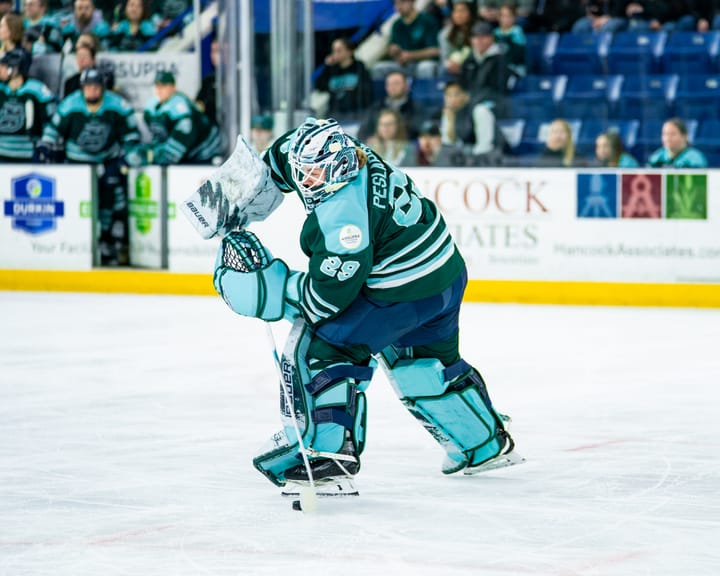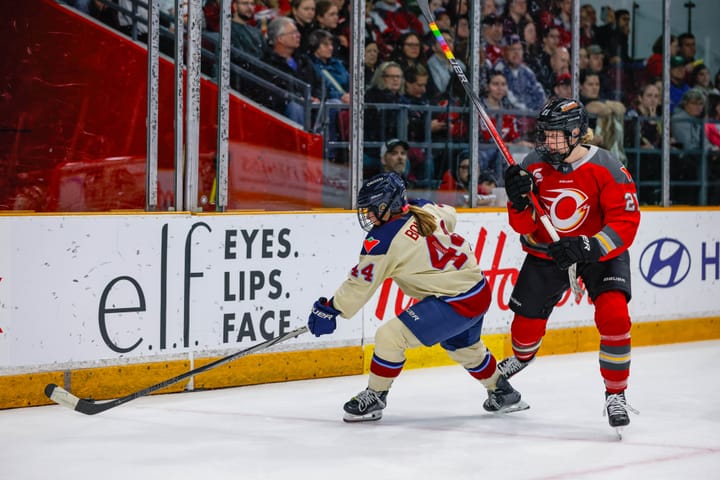Breaking down each team’s performance at Four Nations
How did each team fare at Four Nations?
Team USA walked away with the gold medal at the 2017 Four Nations Cup...which may be good news for them (knocks on wood).
In the five 4 Nations Cups prior to the Olympics, the winner of the 4 Nations Cup has always won the Gold Medal. USA won this year, they also won in 1997. Canada won in 01, 05, 09 and 13.
— Jared Book (@jaredbook) November 13, 2017
Canada took silver and Finland (barely) earned the bronze medal, while Sweden suffered a heartbreaking loss in OT after pushing the Finns to the brink.
Now that the tournament is over, here are some of our thoughts on each team.
USA
The US had no problem finding the back of the net. They scored 22 goals in four games while only giving up five. Twelve different players recorded goals, including defender Emily Pfalzer with a hat trick in the first game, showing a scoring depth that’s excellent news for USA.
Late addition — and youngest player on the team by a few years — Cayla Barnes played especially well. She had two goals, both of which came on the power play. The only other player with two power play goals: Hilary Knight. She also had one assist, giving her three points. Barnes was strong on defense paired with one of the oldest on the team, Kacey Bellamy. The pair looked like they had been playing together for years rather than a few days.
One oddity for the US - neither Jocelyne nor Monique Lamoureux played in the tournament - they were healthy scratches. While a bit of a strange move for the US, this could be so the coaching staff could test out lines and chemistry with some of the newer faces on the team. Time will tell how this plays out.
The biggest issue throughout the tournament (and this is nitpicking) was their lack of discipline against Canada. In the four games, the US took 22 total penalties.
Canada
It’s back to the drawing board for Canada...again.
It looked like Canada had a good chance to take this tournament after a strong showing in Boston a couple of weeks ago against the US, where the offense came alive in a 5-1 win.
That was not the same team that showed up to Four Nations.
You can point at a lot of things that Canada struggled with; they didn’t have their assumed No. 1 goaltender, Shannon Szabados, in net, half of their goals came from just two players (Jennifer Wakefield and Megan Agosta), they struggled scoring at even strength (six of their 18 goals were on the power play)...but ultimately, this is a team that couldn’t respond against the US. They were outscored by the Americans 9-3 in two games; when USA struck first in the gold-medal game, they didn’t have an answer, and costly penalties late in the third opened the floodgates for three goals in less than five minutes to put the game way out of reach.
Canada still has cuts to make before PyeongChang, and its worth noting they were able to easily dispatch Finland, who beat them in a stunning 4-1 loss at the last World Championships, but this is not a good look for them.
Finland
While Team Finland’s conditioning showed they’re able to skate with the best of the best the United States and Canada have to offer, lack of discipline cost the Naisleijonat all tournament long. 24 minors in fours games - 48 minutes on the penalty kill - robbed the team’s scorers of both momentum and opportunity. The team is certainly capable of more than seven goals in four games, but the stymied offense took its toll.
22-year-old goaltender Eveliina Suonpää rose to the occasion when she was called in relief of Meeri Räisänen against the United States. She made 17 saves in just over two periods, then 17 more the next day in the Naisleijonat’s 3-1 victory against Sweden.
Despite coming away with their third consecutive bronze, this is not the tournament Finland would’ve liked to have. They’re in a bit of an awkward spot at the moment - you can see when they skate against teams like Sweden that they’re a step above, but against the US and Canada they still can’t match their talent level.
In order to take that next step into the top tier, they’ll need to get their offense going. This was a tournament where they had a chance to do that, but they fell flat.
Sweden
This poor team. After enduring just about every possible debacle in their battle just to get to the United States, the Damkronorna looked dead in the water for most of the tournament. They finally came alive in the bronze medal game against arch-rival Finland and pushed the Naisleijonat to overtime only to lose on a power play goal.
The good news? The Damkronorna put aside exhaustion and frustration to play 60 full minutes of hockey and give themselves a shot at the bronze. The bad news? They lost, in heartbreaking fashion. The Swedish women can’t catch a break, and their Federation shows no interest in helping them do so.
What we did see in this tournament is the way that Sweden will have to play in order to keep them in games against some of the top teams in the world. Ignore the games where the Swedes got blown out of the water - they took Finland to overtime in the bronze medal game by stopping the Finns from scoring. Regardless of whether Sweden can keep up with or match the skill level of their opponent, if they can keep the offense to the outside of the ice and rely on their goaltender to make big saves, they’ve got a shot.
Is it a great strategy? Absolutely not. But it’s what Damkronorna have to work with for now.





Comments ()